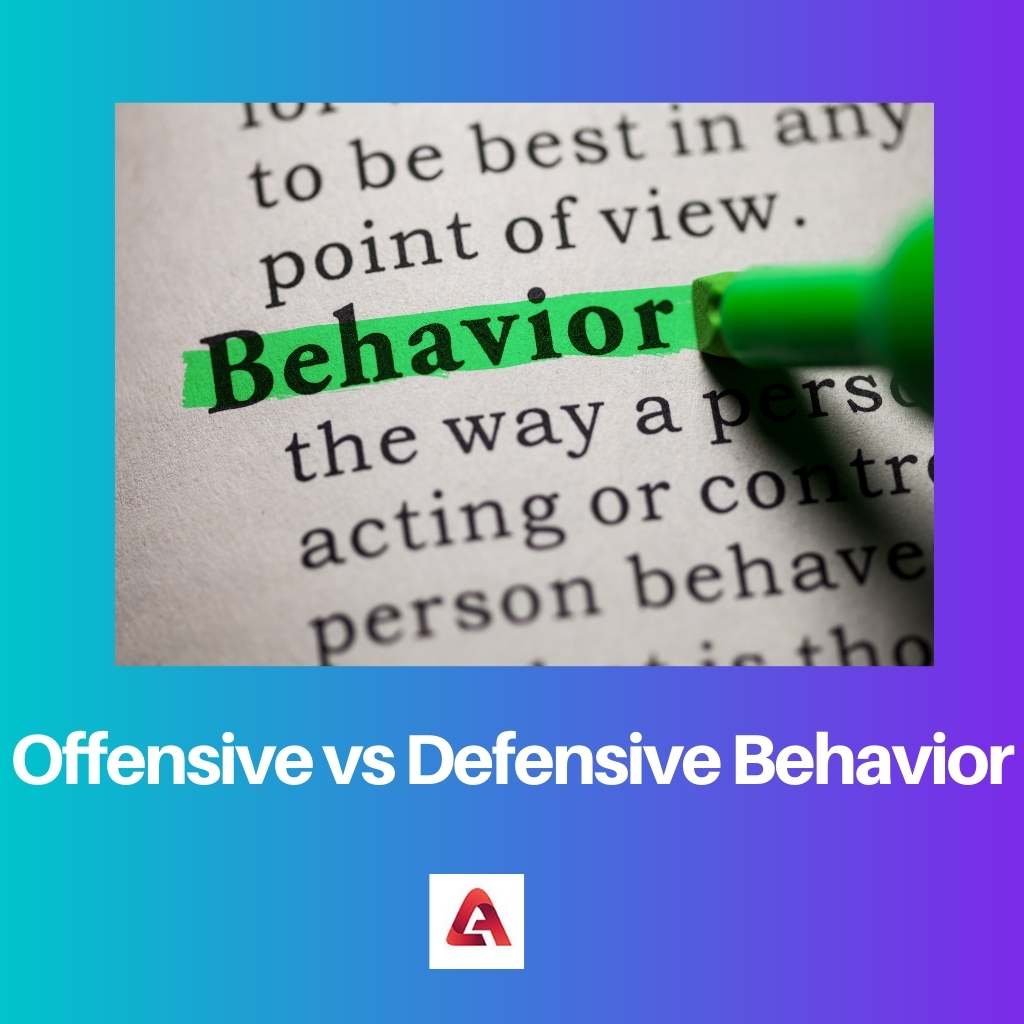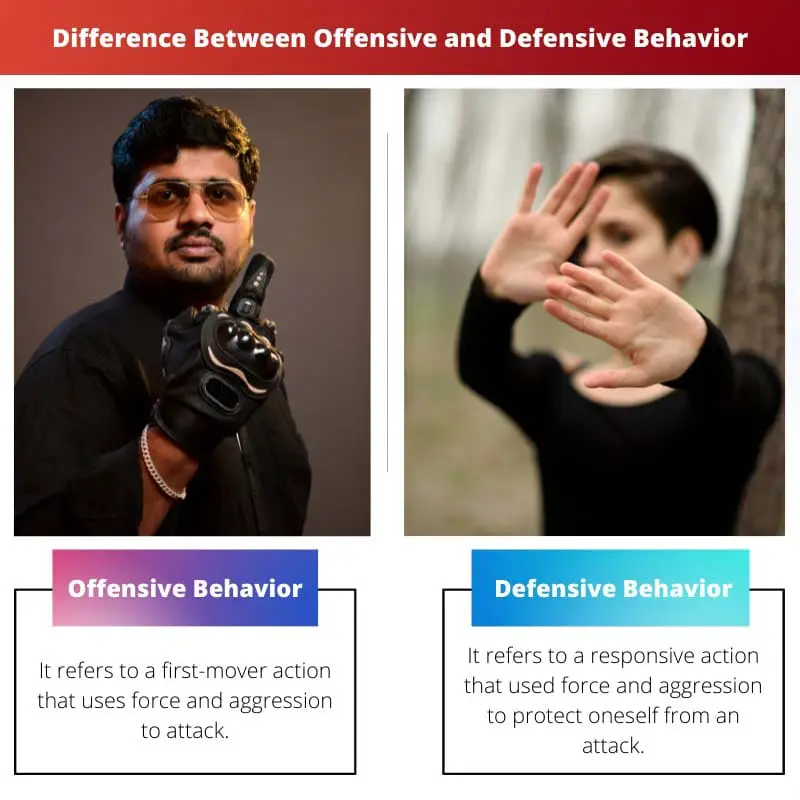It is natural for people to exhibit offensive and defensive behaviors, especially in a situation of conflict. Both of these are a form of psychological response, and they vary in different cases.
However, it is important to know what characterizes these behaviors in order to handle and respond to them correctly.
Key Takeaways
- Offensive behavior aims to attack or dominate others, to gain control or assert authority, while defensive behavior seeks to protect oneself from perceived threats or criticism.
- Offensive behaviors may include aggression, manipulation, or intimidation, while defensive behaviors involve avoidance, denial, or rationalization.
- Understanding and managing offensive and defensive behaviors can improve communication, resolve conflicts, and promote healthier relationships.
Offensive vs Defensive Behavior
Offensive behavior is defined as deliberately attacking or engaging in hostile actions towards another person or group, with the purpose of causing harm. Defensive behavior is defending oneself or others against damage, either physically or verbally, or by avoiding potentially dangerous circumstances entirely.

Offensive behavior can be looked at as the dominant conduct between the two. In such a situation, the person exhibiting the behavior refuses to be submissive.
It involves using certain techniques to attack someone. This kind of action has a certain purpose and is normally done consciously. It is characterized by confidence, indifference, territoriality, aggression, etc.
Meanwhile, defensive behavior is only a response to the former. It can be looked at as submissive conduct. Such behavior is exhibited to protect oneself from attacks.
It is done purely out of instinct. Unlike offensive behavior, which is most visible, defensive behavior may be visible or subtle.
Comparison Table
| Parameters of Comparison | Offensive Behavior | Defensive Behavior |
|---|---|---|
| Meaning | It refers to a first-mover action that uses force and aggression to attack. | It refers to a responsive action that used force and aggression to protect oneself from an attack. |
| Nature | It is dominant conduct. | It is submissive conduct. |
| Cause | It is exhibited consciously. | It is exhibited purely out of instinct. |
| Goal | It has a specific goal or purpose. | It does not have a specific goal or purpose. |
| Traits | It involves confidence, indifference, territoriality, aggression, etc. | It involves fear, denial, projection, regression, sublimation, etc. |
| Visibility | It is visible. | It may be visible or subtle. |
What is Offensive Behavior?
Offensive behavior is a form of conduct that uses force and aggression to attack someone. It has a dominant nature, and the person exhibiting it refuses to submit to anyone.
The person exhibiting an offensive behavior always strikes first, that too with the aim of reaching a specific goal or purpose.
Some character traits of a person with offensive behavior include confidence, indifference, territoriality, aggression, etc. These can be visibly identified in the person.
In doing so, the person being attacked can make coherence out of the situation and furthermore act appropriately.
Since offensive behavior is used to reach to a goal, it is done consciously. This means that the person is aware of his actions. In such cases, it is seen that the person acts inconsiderate, provocative, and self-centered.
The person also has a very short temper. Exhibiting such behavior creates a cycle of stress, agitation, and tension.
An example of offensive behavior is when a predator kills prey for food in the wild. This involves the predator being aggressive, indifferent, and dominant.
It takes the first action. Another example is when a fighter attacks his or her opponent first in a UFC match.

What is Defensive Behavior?
Defensive behavior is only a response to offensive behavior. It involves the use of force and aggression to protect oneself from attacks. It has a submissive nature and no specific goal.
While offensive behavior is visible, defensive behavior may be visible or subtle.
Some character traits of a person exhibiting defensive behavior include fear, denial, projection, regression, sublimation, etc. When a person is attacked, he may or may not be able to make sense of the situation at that time.
For this reason, it is natural for defensive behavior to turn into offensive behavior. In doing so, the person uses escapism and diversion for protection.
Unlike offensive behavior, defensive behavior is purely instinctual. A person may or not be conscious of his behavior at that time. This may happen when the offensive person attacks too quickly or aggressively.
However, when exhibited consciously, defensive behaviors have the potential to break negative cycles of offensive behaviors.
An example of defensive behavior is when a cat hisses, spits, arches its back and raises its hair on coming across some threat. Another example is when a fighter blocks the punches and kicks of the opponent while partaking in a UFC match.

Main Differences Between Offensive and Defensive Behavior
- Offensive behavior refers to a first-mover action that uses force and aggression to attack whereas defensive behavior refers to a responsive action that uses force and aggression to protect oneself from an attack.
- Offensive behavior is dominant conduct, whereas defensive behavior is submissive conduct.
- Offensive behavior is exhibited consciously, whereas defensive behavior is exhibited purely out of instinct.
- Offensive behavior has a specific goal or purpose, whereas defensive behavior does not have a specific goal or purpose.
- Offensive behavior involves confidence, indifference, territoriality, aggression, etc., whereas defensive behavior involves fear, denial, projection, regression, sublimation, etc.
- Offensive behavior is visible, whereas defensive behavior may be visible or subtle.


Understanding the difference between offensive and defensive behaviors is crucial in handling conflicts. The examples provided make it easier to comprehend the topic. Although the aggressive nature of offensive behavior can seem dominant, defensive behaviors are triggered by pure instinct, which empowers the one being attacked.
This comparison clearly shows the characteristics of offensive and defensive behaviors. The table highlights the nature and causes of these behaviors, providing an insightful perspective. It’s important to note that defensive behaviors might not always have a specific goal or purpose.
It’s intriguing to learn how offensive and defensive behaviors play a significant role in human actions. Defensive behaviors, stemming from instinct, are notably different from offensive behaviors, which are exhibited consciously. This understanding can shed light on resolving conflicts and fostering healthier relationships.
So, what you’re saying is, if someone comes at me, I should either be confident and aggressive, or fearful and in denial? Got it. Seems like a foolproof plan for healthier relationships. This has sarcasm written all over it, but it’s a fantastic insight into the human psyche. Kudos.
This informative post provides good insight into human behavior. Understanding the nature of offensive and defensive behaviors could help improve relationships, and promote better communication. The comparison table is especially helpful.
A thought-provoking post about the complex nature of offensive and defensive behaviors in humans. It’s interesting to recognize the visible and subtle traits of defensive behavior, contrasting with the clearly visible traits of offensive behavior. This creates a broader understanding of human actions and reactions.